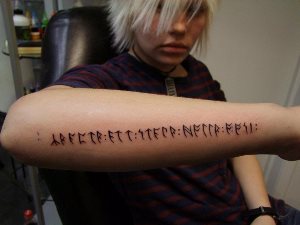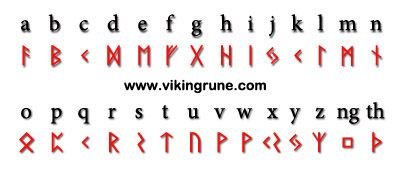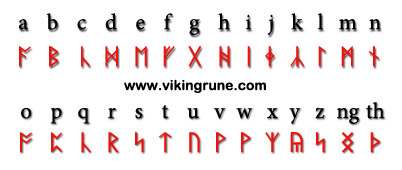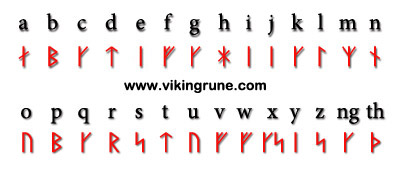 Developing a great design for a tattoo is critical in case you seriously plan to get inked. If you are about to have a Norse or Viking tattoo, I bet you want to include some Nordic runes into it. Tattooed inscriptions in foreign languages or written in unusual characters may well be a source of trouble, especially if you don’t know well the language or the writing system. Online translation tools may play a trick on you: a woman who wanted to have “I love David” in Hebrew on her back, later realized the actual tattoo said “Babylon is the world’s leading dictionary and translation software”. David Beckham inked his wife’s name on his left forearm in Hindi but misspelt it. The tattoo read Vihctoria instead of Victoria with additional h. The name is well known in India because of Queen Victoria, so the person who developed the tattoo design probably wasn’t a native Hindi speaker and even did not know the language well. Perhaps you wouldn’t like to be in such a situation with your runic inscription, would you?
Developing a great design for a tattoo is critical in case you seriously plan to get inked. If you are about to have a Norse or Viking tattoo, I bet you want to include some Nordic runes into it. Tattooed inscriptions in foreign languages or written in unusual characters may well be a source of trouble, especially if you don’t know well the language or the writing system. Online translation tools may play a trick on you: a woman who wanted to have “I love David” in Hebrew on her back, later realized the actual tattoo said “Babylon is the world’s leading dictionary and translation software”. David Beckham inked his wife’s name on his left forearm in Hindi but misspelt it. The tattoo read Vihctoria instead of Victoria with additional h. The name is well known in India because of Queen Victoria, so the person who developed the tattoo design probably wasn’t a native Hindi speaker and even did not know the language well. Perhaps you wouldn’t like to be in such a situation with your runic inscription, would you?
Many runic tattoo designs include a name. You may want to have inked in runes the name of a beloved one, your own name, or a name of a deceased person who was important in your life. Now if we are to spell it in the Elder Futhark runes, we have to look deeper into what spelling is and have a look at the following facts:
-
The ideal alphabet has a separate symbol (letter or rune) for each sound the language has.
-
The Elder Futhark runic alphabet was such an ideal system: there are as many Elder Futhark runes as there were sounds in the Proto-Norse language, for which they were developed.
-
Roman letters used to transcribe the English language today do not constitute an ideal alphabet. Several sounds (have a look at the IPA chart of English) do not have letters of their own. They are transcribed with letters or combinations of letters used for other sounds as in ch for [tʃ] and sh for [ʃ].
-
The Phonological system (sound system) of the Proto-Norse language was not the same as in modern English. It had sounds that do not exist in English. It also did not have some sounds that do exist in English: for instance English has the sounds [tʃ] [dʒ] [ʃ] [ʒ], whereas Proto-Norse did not have them.
-
If we try to use the Elder Futhark runes phonetically, that is substituting runes for the sounds we hear, the way runes were supposed to be used, we will fail, because there are not enough runes for all the English sounds.
So the solution is to keep modern English spelling. It is true that ancient rune carvers did not use it. However, it is also true that they did not have to transcribe words containing sounds like [tʃ] [dʒ] [ʃ] [ʒ]. Should they have to, they would invent a way to do so. Not necessarily combining s and h for [ʃ] as in ‘shame’ or c and h for [tʃ] as in ‘child’. May be they would even invent something more logical than using as many as three variants for one and the same sound [dʒ] as in ‘gin’, ‘joy’, and ‘edge’.
Even though keeping the English orthography eliminates the most of the problems, some still remain. First, there are 26 Roman letters in the English alphabet and only 24 runes in the Elder Futhark. Second, not all of the runes have obvious counterparts in Roman letters, for instance the *eihwaz rune denoted a phoneme with the sound value between [i] and [e]. Since we have *isa and *ehwaz for English i and e, *eihwaz remains unemplyed. Below is a table of letters and their runic counterparts, showing how all this can be resolved:

Note that this way to collate letters and runes is not canonical. It is based on my own understanding of phonology and orthography. No one has ever decreed ex cathedra that such a set of counterparts—fixed as the ‘right’ or ‘correct’ one—should at all exist. There has been no social contract concluded to this effect, either. An algorithm based on this table is behind the rune converter that I developed. You may see other tables of counterparts on the Internet that suggest different solutions. Keep in mind that you may also find phonetic explanations of runes, which were not compiled as a help for those who want to write a name in runic symbols. In such cases as my earlier post the counterparts denote the letters used to transcribe ancient runic inscriptions. Here is also the table for the Anglo-Saxon runes known as the Anglo-Saxon Futhorc:

The Younger Futhark runic alphabet has only 16 runes. It uses one and the same rune for such pairs as [p] and [b], [t] and [d], [k] and [g]. So such names as ‘Tina’ and ‘Dina’ will look the same in these runes. The words ‘Pat’, ‘pad’, ‘bat’ and ‘bad’ will be identical as well. So before any permanent use I would strongly advise to check for all possible readings of the resulting Younger Futhark rune sequence. If the name can be read as some other word as well, you’d better know it before you get a tattoo. For example, the word ‘big’ may be read ‘pig’ as well, which may turn as a rather unpleasant surprise. Since the same rune is used for both [i] and [e], the same word in runes may also be read as ‘beg’ and ‘peg’. Note that there is only one rune for [u] and [o], too. The table for the Younger Futhark runes is as follows:

The appearance of runes in the charts above is not the only possible one. There have been many variants of runes depending on geographical area and historical period. For instance, beside the so called long branch Younger Futhark, pictured above, there was a short twig variant as well. Later it was transformed into the so called medieval runes.
Note that the principles set up in this article are apllicable not only to names, but to any word, phrase or text in English as well (however, not to Old Norse texts).
See also:
A Guide to Writing in Norse Runes
How to Translate into Runes Correctly
How to Write an Authentic Runic Inscription
Should I Write in Runes Phonetically?
Photo courtesy © NirvanaOfTime

Hi, thanks for putting together such an informative website. I’ve read the comments to avoid asking what has already been asked…..but my question is. My daughters name is Freya as we loved the name and the mythology. I want to have her name tattoo’d and have used your converter together with reading other websites. I also want to have her date of birth done but can find no instructions or information as to how Vikings (i’ll be using lower futhark ) wrote dates and or numbers? Also is ‘Freya’ recorded anywhere is should it be spelt as per the alphabet and converter? Long message, sorry
Hello Doug. To help you, I should first understand what type of runes do you have in mind. What do you mean by the ‘lower futhark’? The elder or the younger one? As for dates and numbers, there were no runes for them.
The Old Norse name Freyja would have looked like this in the Younger Futhark runes (that were in use during the Viking Age):
Thank you. The Younger is the option I wanted so your reply answers that. Have you any suggestions as to how to do her date of birth that would be in keeping with the period? Was looking to extend the tattoo so that seemed like a good way of doing it. It’s the 8th October 2004, did they break the year into months and if so where did October fit in?
Doug, I am not aware of a reliable way to convert a date to a Viking calendar. Instead, I would suggest to write the date with Roman numerals. They look great along with the runes, and they were used during the same period (even though by Romans). The date 10/8/2004 would look like X.VIII.MMIV.
Thank you, appreciate the insight and help
Hello. Can you please show me the runes for HMT and the number 57
There were no runes for the numbers. As for letters, it depend on what type of runes you actually need. See the tables above for each respective type.
when trying to convert my last name in long branch in younger futhark, the I J and E are all the same symbol. But since im swedish i wasn’t planning on using elder. Is it something ill just have to deal with?
Hello Taylor. Yes, Younger Futhark had a very small number of symbols. More on that here: Younger Futhark Runes: Were They Convenient?
Hello!
I need some help for writing my name in long branch runes.
My name is Cavin and is spoken like Kevin.
The converter shows me the fé rune for the v, but i think the úr rune would fit better, because of its phonetically sound.
Am i right or wrong?
Thanks!
The úr rune is closer to w as in win. V as in victory is represented by the fé rune.
Hi, the letter V is very controversial in the younger futhark.
There is concrete evidence, such as the Vallsjö runestone in Sweden that the letter v/u is associated with the rune ᚢ. But it is very difficult to give the same correct interpretation for all occasions.
Example of the Vallsjö runestone:
: .ᚢᚽᛋᛏᛁ: ᛅᚢᚴ: ᛁᚢᛅᚱ: ᛅᚢᚴ ……. etc…(go and see the photos of the stone)
Original Rune TEXT
÷ uesti: auk: iuar: auk: s (u) [lfa:] (b) ruþr: þriʀ: karþu: bru: þasi: (a) uk: satu: stein: þana: eftiʀ: þialfa: faþur: [sin]
Old Norse
Véseti ok Ívarr ok Sylfa, brœðr þrír, gerðu brú þessa ok settu stein þenna eptir Þjalfa, fǫður sinn.
Eng
Véseti and Ívar and Sylfa, the three brothers made this bridge and placed this stone in memory of Þjalfi (Thjalfi), their father.
How would you write Matthew in runes?
Depends on the type of runes. There are tables for several runic alphabets above.
Hi
I have a problem with my name witch is a slavic name Jarosław.
the symbol ” Ł ” is read as you read ” W ”
and a slavic ” W ” is as english ” V ”
so I’m totaly lost think you can help?
Pronunciation of dark Ł as /w/ in Polish developed in the 16th century. I am not a big fan of phonetical use of the runes (Should I Write in Runes Phonetically?) so I would use one and the same rune for both L and Ł. As for w, yes, it corresponds to v in modern English.
Hello there!
My father’s name was Nikolaos.he passed away on June 28th. I would like to get a tattoo with his name in runes. Which type of them do you propose me. Which type do you it would represent his name if a viking could pronounce his name. Thank you in advance
Hello Apostolos. My condolences on the passing of your father. I would suggest the long branch variant of the Younger Futhark runes. They were used throughout Scandinavia in the Viking Age.
Thanks a lot, I really appreciate it. I will do that when the fall comes. Take care.
You are welcome, friend.
Hello!
I was asked to tattoo Idunn’s name (the norse goddess) in runes and I am doing some research about it… I used the rune converter but I am not sure if it goes exactly like that. Could you help me?
Hello Mariel. The Old Norse form of this name is Iðunn. Follow this tutorial to write it appropriately: How to Write in Old Norse with Runes.
OK!! thank you so much.
Would it be like this?
(with the rune names): īsaz, Þurisaz, ūruz, naudiz
Mariel, you name the runes by their Elder Futhark names, while actually in this case they are Younger Futhark runes. But your version is correct:
Hi,
Working on an art project, I would like to use runic names of the 2 Mabagarms “Hati” and “Sköll”.
I searched a moment on the internet and didn’t find any phonetic translation.
So I tried to do it myself but I’m not sure of the result.
This is what I found
hati = Hagalaz + Ansuz + Tiwaz + Isaz OR Eihwaz (I think it’s Isa)
sköll = Sowilo + Kaunan + Othalan + Laguz
I would be really happy if you could correct me.
thank you in advance.
Hello Sanjar. The runic system used for Old Norse was the Younger Futhark. Follow this tutorial to write these names appropriately: How to Write in Old Norse with Runes.
How can I translate my departed grandmother’s name into Anglo Saxon runes? Her name was Mary. I am also looking for a translation of the word “freedom”.
Thanks!
Hello Cody. My free online rune converter will help.